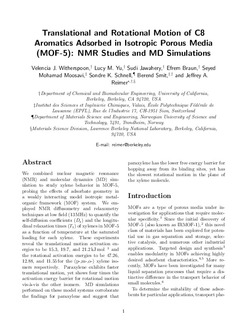| dc.contributor.author | Witherspoon, Velencia J. | |
| dc.contributor.author | Yu, Lucy M. | |
| dc.contributor.author | Jawahery, Sudi | |
| dc.contributor.author | Braun, Efrem | |
| dc.contributor.author | Moosavi, Seyed Mohamad | |
| dc.contributor.author | Schnell, Sondre Kvalvåg | |
| dc.contributor.author | Smit, Berend | |
| dc.contributor.author | Reimer, Jeffrey A. | |
| dc.date.accessioned | 2017-11-09T11:37:06Z | |
| dc.date.available | 2017-11-09T11:37:06Z | |
| dc.date.created | 2017-08-08T15:58:08Z | |
| dc.date.issued | 2017 | |
| dc.identifier.citation | Journal of Physical Chemistry C. 2017, 121 (28), 15456-15462. | nb_NO |
| dc.identifier.issn | 1932-7447 | |
| dc.identifier.uri | http://hdl.handle.net/11250/2465201 | |
| dc.description.abstract | We combined nuclear magnetic resonance (NMR) and molecular dynamics (MD) simulation to study xylene behavior in MOF-5, probing the effects of adsorbate geometry in a weakly interacting model isotropic metal organic framework (MOF) system. We employed NMR diffusometry and relaxometry techniques at low field (13 MHz) to quantify the self-diffusion coefficients (Ds) and the longitudinal relaxation times (T1) of xylenes in MOF-5 as a function of temperature at the saturated loading for each xylene. These experiments reveal the translational motion activation energies to be 15.3, 19.7, and 21.2 kj mol–1 and the rotational activation energies to be 47.26, 12.88, and 11.55 for the (p-, m-, o-) xylene isomers, respectively. Paraxylene exhibits faster translational motion, yet shows four times the activation energy barrier for rotational motion vis-à-vis the other isomers. MD simulations performed on these model systems corroborate the findings for paraxylene and suggest that paraxylene has the lower free energy barrier for hopping away from its binding sites, yet has the slowest rotational motion in the plane of the xylene molecule. | nb_NO |
| dc.language.iso | eng | nb_NO |
| dc.publisher | American Chemical Society | nb_NO |
| dc.title | Translational and Rotational Motion of C8 Aromatics Adsorbed in Isotropic Porous Media (MOF-5): NMR Studies and MD Simulations | nb_NO |
| dc.type | Journal article | nb_NO |
| dc.type | Peer reviewed | nb_NO |
| dc.description.version | acceptedVersion | nb_NO |
| dc.source.pagenumber | 15456-15462 | nb_NO |
| dc.source.volume | 121 | nb_NO |
| dc.source.journal | Journal of Physical Chemistry C | nb_NO |
| dc.source.issue | 28 | nb_NO |
| dc.identifier.doi | 10.1021/acs.jpcc.7b03181 | |
| dc.identifier.cristin | 1484961 | |
| dc.relation.project | Norges teknisk-naturvitenskapelige universitet: enersense: 68024013 | nb_NO |
| dc.relation.project | Notur/NorStore: NN9414K | nb_NO |
| dc.description.localcode | © American Chemical Society 2017. This is the authors accepted and refereed manuscript to the article. LOCKED until 19.5.2018 due to copyright restrictions | nb_NO |
| cristin.unitcode | 194,66,35,0 | |
| cristin.unitname | Institutt for materialteknologi | |
| cristin.ispublished | true | |
| cristin.fulltext | postprint | |
| cristin.qualitycode | 1 | |
